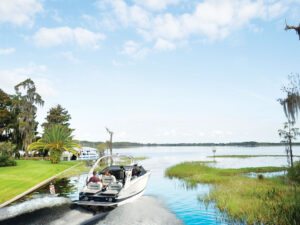
My boat does not have a kill switch.
Excuse me, I should have said my boat does not have an engine cutoff switch (ECOS). The marine industry would really prefer that we don’t use the K-word. In fact, back when I was a wet-behind-the-ears buckaroo PR associate at OMC, the legal department informed me there were two words that should never be used in public-facing corporate communications: kill and safety. The goal was not to imply that any company products are either dangerous or safe. Because lawsuits, of course.
This publication will henceforth use the term ECOS. You, dear reader, are free to continue calling that red lanyard the kill switch.
The ECOS became a topic of discussion at the Lake View Inn when I informed the crew assembled at the worn blue Formica bar that as of April 1, operators of recreational vessels less than 26 feet in length will be required to use an ECOS as the United States Coast Guard implements a law passed by Congress. There was a moment of silence as the assembly pondered for a bit. Everyone at the bar owns a boat less than 26 feet long.
“I hate that kill-switch gizmo,” said my good friend Chuck Larson, the first patron to break the silence.
“Oh, Chuck, have you already forgotten the Bud Jorgensen incident?” replied Jackie Quade as she leaned forward over her brandy old-fashioned to look down the bar at my good friend. “I had to ride out on the WaveRunner to pick up the kids and save his dumb butt.”
Faithful readers may recall the story of Bud falling overboard while towing his daughters in a tube with his 14-foot Alumacraft.
“Yeah, but Bud wasn’t thinking, and that was a tiller motor,” Chuck said. “Boating is supposed to be about freedom and escape. And I think I’ll run my boat any way I please. Besides, there’s no Coastie Guards on our lake.”
Chuck is correct that the law applies only to waters patrolled by the Coast Guard, but seven states have a similar ECOS law on the books.
“Once it’s a federal regulation, you can bet it will trickle down to the states, and then the DNR will be enforcing it here,” I said. Groans ran down the bar.
“I would use the thing, except the damn clip is so stiff, you end up fighting with it,” Wally said from behind the bar. “It’s like they don’t really want anybody to use it.”
As usual, a good point made by Wally, and one that I’ve brought up to the motor companies. One answer I got was that lawyers engineered the stiff metal clip, wanting it strong so that it could never break. Because liability. A few years ago, Mercury finally switched to a plastic clip that is much easier to use, but I think every other builder still uses a metal clip.
My 1951 Dunphy does not have an ECOS, but my colleague and vintage outboard expert John Tiger assures me I can wire an ECOS into the coil circuit of its Evinrude Lark, and I think that will be my next project. Chuck says a little danger keeps you on your toes, but I really don’t want to be the next Bud Jorgensen.









